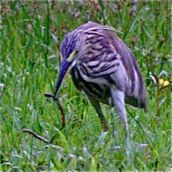Chinese Pond Heron (Ardeola bacchus) is reported to eat small frogs, aquatic invertebrates, fish, molluscs, terrestrial insects and worms.
Daniel Chia photographed the heron catching an earthworm from the field along Port Road, just outside Carpark C of Singapore’s Labrador Nature Reserve.
Picking up the worm from the damp ground was not a problem. Trying to pass it down its long bill for swallowing was. Worms are slippery and the heron had quite a time trying to swallow it. As soon as the worm reached the end of the bill, it wriggled out as apparently there may be less of a grip there than at the bill tip. Persistency prevailed and after many attempts, the heron finally managed to swallow the worm.












4 Responses
Could this be baby snake? It seems to long to be an earthworm to me.
You may be right!
Hi, I’ve checked the full sized image again, and confirm that it was an earthworm.
That particular patch of open grass was waterlogged from the rains that happened over that period, and would have caused the earthworms to surface for air, thus, becoming easy targets for hungry birds…
Wow! That is one long earthworm! I was at Sungei Buloh last sunday and found my 70-300mm too short for birding and lousy image quality too.. need a 400mm F4.